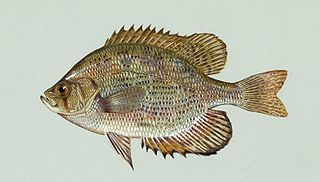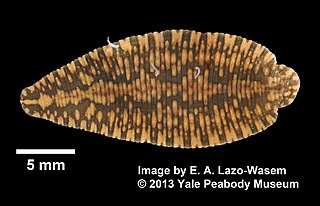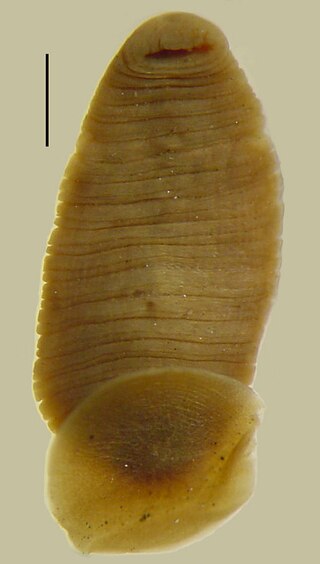
Centrarchidae, better known as sunfishes, is a family of freshwater ray-finned fish belonging to the order Perciformes, native only to North America. There are eight universally included genera within the centrarchid family: Lepomis, Micropterus, Pomoxis (crappies), Enneacanthus, Centrarchus, Archoplites, Ambloplites, and Acantharchus. A genetic study in 2012 suggests that the highly distinct pygmy sunfishes of the genus Elassoma are also centrarchids.

Hirudo medicinalis, the European medicinal leech, is one of several species of leeches used as "medicinal leeches".

Rhynchobdellida, the jawless leeches or freshwater leeches, are an order of aquatic leeches. Despite the common name "freshwater leeches", species are found in both sea and fresh water. They are defined by the presence of a protrusible proboscis instead of jaws, and having colourless blood. They move by "inchworming" and are found worldwide. The order contains 110 species, divided into 41 genera and three families. Members of the order range widely in length, usually between 7 and 40 mm. They are hermaphrodite. The order is not monophyletic.

Ambush predators or sit-and-wait predators are carnivorous animals that capture or trap prey via stealth, luring or by strategies utilizing an element of surprise. Unlike pursuit predators, who chase to capture prey using sheer speed or endurance, ambush predators avoid fatigue by staying in concealment, waiting patiently for the prey to get near, before launching a sudden overwhelming attack that quickly incapacitates and captures the prey.
The Caatinga horned frog is a species of frog in the family Ceratophryidae. It is endemic to Brazil. Its natural habitats are dry savanna, subtropical or tropical dry shrubland, subtropical or tropical dry lowland grassland, and intermittent freshwater marshes. They are voracious predators that use a sit-and-wait feeding strategy to ambush prey, which includes ants and small vertebrates. They are also known to be explosive breeders.

Helobdella is a genus of leeches in the family Glossiphoniidae, the freshwater jawless leeches. They occur worldwide.

Geoplanidae is a family of flatworms known commonly as land planarians or land flatworms.

Arhynchobdellida, the proboscisless leeches, are a monophyletic order of leeches. They are defined by the lack of the protrusible proboscis that defines their sister taxon, the Rhynchobdellida. Arhynchobdellida is a diverse order, compromising both aquatic and terrestrial, besides sanguivorous and predatory, leeches. The order is divided into two suborders, Erpobdelliformes and Hirudiniformes.

Glossiphoniidae are a family of freshwater proboscis-bearing leeches. These leeches are generally flattened, and have a poorly defined anterior sucker. Most suck the blood of freshwater vertebrates like amphibians, crocodilians and aquatic turtles, but some feed on invertebrates like oligochaetes and freshwater snails instead. Although they prefer other hosts, blood-feeding species will opportunistically feed from humans.

Leeches are segmented parasitic or predatory worms that comprise the subclass Hirudinea within the phylum Annelida. They are closely related to the oligochaetes, which include the earthworm, and like them have soft, muscular segmented bodies that can lengthen and contract. Both groups are hermaphrodites and have a clitellum, but leeches typically differ from the oligochaetes in having suckers at both ends and in having ring markings that do not correspond with their internal segmentation. The body is muscular and relatively solid, and the coelom, the spacious body cavity found in other annelids, is reduced to small channels.

Bolbitis heteroclita is an aquatic fern species of Bolbitis, native to the Indochina region of tropical Southeast Asia.
Motobdella montezuma is a species of leech which is only found in Montezuma Well, central Arizona, United States. It is a nocturnal pelagic predator that feeds almost exclusively on the endemic amphipod Hyalella montezuma, which it detects using passive sonar and swallows whole.
Dactylosoma is a genus of parasitic alveolates of the phylum Apicomplexa.

Haemopis sanguisuga is a species of freshwater leech in the family Haemopidae. It is commonly called the horse-leech, but that is due to the similarity of its appearance to the leech Limnatis nilotica, which sometimes enters the nasal cavities of livestock. Haemopis sanguisuga does not behave in this way. Another synonym for this leech is Aulastomum gulo.

Placobdella parasitica is a species of leech found in North America. Leeches are habitual ectoparasites of vertebrates in aquatic environments. Placobdella parasitica is differentiated from other members of the genus Placobdella by its smooth dorsal surface, simple to complicated pigmentation, and abdomen with 8 to 12 stripes.

Erpobdella octoculata is a freshwater leech in the Erpobdellidae family. This species can be found in Europe, the Mediterranean, and the Middle East.

The Piscicolidae are a family of jawless leeches in the order Rhynchobdellida that are parasitic on fish. They occur in both freshwater and seawater, have cylindrical bodies, and typically have a large, bell-shaped, anterior sucker with which they cling to their host. Some of the leeches in this family have external gills, outgrowths of the body wall projecting laterally, the only group of leeches to exchange gases in this way.

Theromyzon tessulatum is a species of leech in the family Glossiphoniidae. It is a haematophagous (blood-sucking) leech, found in freshwater habitats in Europe.

Torix is a genus of Rhynchobdellid leeches in the family Glossiphoniidae, found in Eastern Asia and Japan. Rana japonica, the Japanese brown frog, is the main host of T. tagoi.















